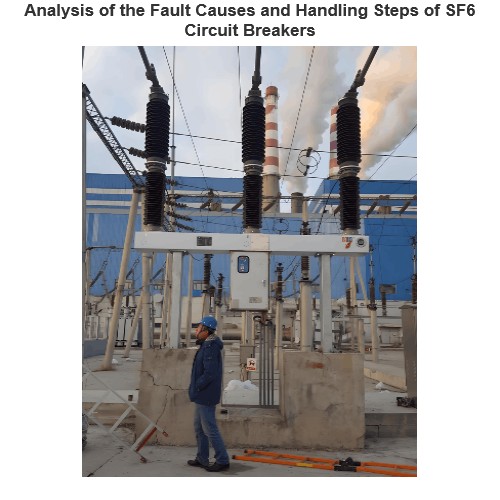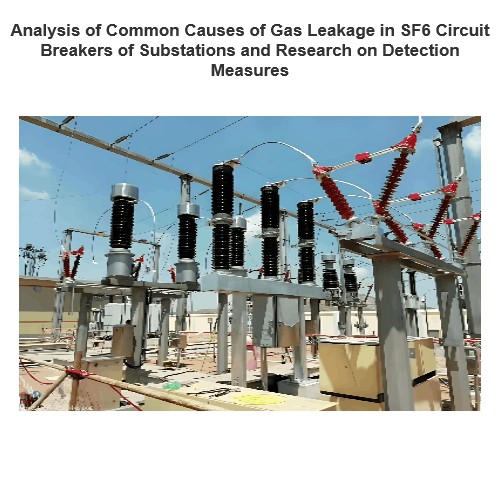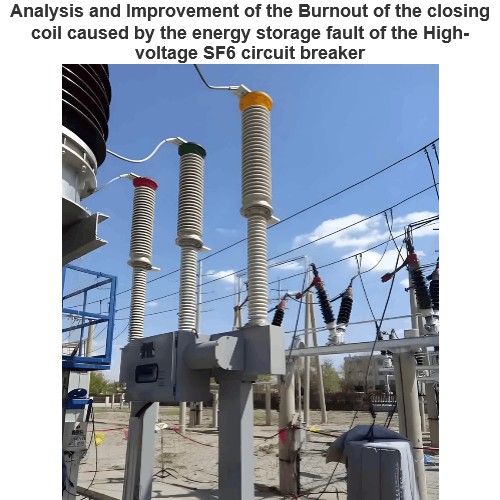The current situation and development trend of high-voltage SF6 circuit breakers

James
05/09/2025
High-voltage circuit breakers, also known as high-voltage switches, possess sufficient interrupting and arc-extinguishing capabilities. They can not only cut off and close the no-load current and load current of high-voltage circuits but also, when a fault occurs in the system, cooperate with protection devices and automatic devices to quickly cut off the fault current, reducing the power outage range and preventing the expansion of the accident. This is of great significance for ensuring the safe operation of the power system.
High-voltage circuit breakers have evolved through oil circuit breakers, compressed air circuit breakers, vacuum circuit breakers, and SF₆ circuit breakers. Among them, the first two types have gradually been phased out, and SF₆ circuit breakers are more commonly applied compared to the latter two. SF₆ circuit breakers were widely adopted in the early 1970s. They use sulfur hexafluoride as the arc-extinguishing medium. This type of circuit breaker has a large interrupting capacity. Under free interruption conditions, its interrupting capacity is approximately 10 times higher than that of other circuit breakers. It plays a crucial role in the stable and safe operation of the power system and is also of great significance in terms of economic and social benefits.
1. Performance of SF₆ Circuit Breakers
SF₆ circuit breakers are oil-free switching equipment that uses SF₆ gas as both the insulating and arc-extinguishing medium. Their insulation performance and arc-extinguishing characteristics are significantly higher than those of oil circuit breakers. Sulfur hexafluoride circuit breakers have the following characteristics:
- Strong arc-extinguishing ability, high dielectric strength, and high withstand voltage value of the unit fracture. As a result, under the same rated voltage level, the number of series fracture ports required is reduced, improving the economic performance of the product.
- Long electrical life. It can continuously interrupt at a full capacity of 50kA for 19 times, and the cumulative interrupting current can reach 4200kA. The maintenance cycle is long, and it is suitable for frequent operation.
- Good interrupting performance. Due to the electronegativity of SF₆ gas, it has a strong ability to adsorb free electrons. The arc formed in SF₆ is conducive to the formation of the "arc column structure" (arc core and arc sheath). The diffusion of ionized plasma is restricted, enabling effective ion recombination. The interrupting current is large, reaching 80-100kA, and even 200kA. The arc-extinguishing time is short, generally 5-15ms. At the same time, the interrupting performance for reverse-phase interruption, near-zone faults, unloaded long lines, and transformer no-load conditions is also good.
- High insulation performance. The insulation strength of SF₆ is approximately 5-10 times that of air.
- SF₆ gas is colorless, odorless, non-toxic, non-flammable, and a very stable gas that is not easy to react with other substances. In addition, when the circuit breaker is opened, the pressure increase caused by the arc heating is extremely small, ensuring reliable operation and preventing explosion accidents.
2. Development of High-voltage SF₆ Circuit Breakers
2.1 Double-pressure SF₆ Circuit Breakers
2.1 Double-pressure SF₆ Circuit Breakers
Two SF₆ gas systems (high-pressure system and low-pressure system) are set inside the circuit breaker. Only during the opening process, the high-pressure chamber flows to the low-pressure chamber through the control of the blowing valve to form a high-pressure gas flow. After the interruption is completed, the blowing valve is closed. The principle of the arc extinguishing chamber is that a gas compressor and pipes are connected between the high-pressure chamber and the low-pressure chamber. When the gas pressure in the high-pressure chamber decreases or the gas pressure in the low-pressure chamber rises to a certain limit, the gas compressor starts to pump the SF₆ gas in the low-pressure chamber to the high-pressure chamber, forming an automatic closed-loop gas system.
2.2 Single-pressure SF₆ Circuit Breakers
The single-pressure structure is simple and can adapt to a wide range of ambient temperatures. The gas compression type has also gone through a development process: in terms of arc blowing, the first-generation single-pressure type has a single-blow structure, with a small interrupting current (generally 31.5kA) and a low fracture port voltage (generally 170kV). The second-generation single-pressure type has a double-blow structure, with the interrupting current increased to (40-50kA), and the fracture port voltage is still low. Generally, 252kV products have double fracture ports. The third-generation single-pressure type has a double-blow structure supplemented by a thermal expansion effect (hybrid arc extinguishing). The interrupting current is large, increased to 63kA, and the fracture port voltage is high. A single fracture port can reach 252kV, 363kV, 420kV, and even 550kV.
The development of the single-pressure type, from the perspective of the arc extinguishing chamber, has adopted a smaller gas compression piston. The advantages brought by the reduction of the piston in the arc extinguishing chamber are as follows:
- The mass of the entire motion system during the interruption process of the product is reduced.
- The operating power of the product is reduced.
- The buffering of the product becomes easier, and the mechanical life is long.
2.3 Self-energy SF₆ Circuit Breakers
Self-energy SF₆ circuit breakers have two arc extinguishing principles: the thermal expansion principle and the arc rotation principle. Currently, the vast majority of self-energy circuit breakers utilize the thermal expansion principle. The self-energy principle is to use the arc energy to heat the SF₆ gas in the expansion chamber, build pressure, form a gas flow, and extinguish the arc. However, when interrupting small currents, due to the small arc energy, a small piston is required to compress the gas to form an auxiliary blow. Due to the significant reduction in operating power, a spring operating mechanism with a simple structure can be used. The thermal expansion type has now developed to the second generation. The first-generation products achieve the effect of reducing the operating power by reducing the gas compression energy required for arc extinguishing. The diameter of the gas compression piston is designed according to the interrupting of 30% of the maximum fault current, and the motion mass is also small, which reduces the operating power. The second-generation products further improve the thermal expansion effect and the interrupting performance, not only improving the interrupting of capacitive current but also further reducing the operating power.
2.4 Intelligent SF₆ Circuit Breakers
Another characteristic of modern high-voltage circuit breakers is their intelligence, evolving from traditional electromechanical systems into modern intelligent systems centered around computers. Currently, the online detection contents of high-voltage circuit breakers are as follows:
- SF6 gas;
- Operating mechanism system;
- Release;
- Control and auxiliary circuits;
- Power transmission chain.
Through these detections, more than 90% of the faults can be discovered. Online detection can change the regular maintenance of circuit breakers to real-time condition-based maintenance.
3. Porcelain Post Type and Tank Type SF₆ Circuit Breakers and Their Applications
China first applied SF₆ circuit breakers in 1970 when the Northeast Electric Power Administration imported three H-912 type 220KV double-pressure porcelain post type SF₆ circuit breakers produced by Siemens from abroad and installed them in the HuShitai primary substation in Shenyang. They are still operating well today.
High-voltage sulfur hexafluoride circuit breakers are divided into porcelain post type and tank type according to their structure. When comparing the two, they each have their own characteristics:
- Both porcelain post type and tank type high-voltage SF₆ circuit breakers can meet the requirements of high voltage and large capacity. The arc extinguishing chamber of the porcelain post type is installed on the insulating support. By connecting the arc extinguishing chambers in series and installing them on the insulating support at an appropriate height, any rated voltage value can be obtained. The insulating support is mostly a porcelain post, and organic composite supports have also emerged. The arc extinguishing chamber of the tank type is installed in a metal tank connected to the ground potential. Under high voltage, multiple arc extinguishing chambers need to be connected in series and installed in the same tank for each phase.
- Installation of current transformers. In terms of installing current transformers, porcelain post type circuit breakers are at a disadvantage. Because the arc extinguishing chamber of the porcelain post type is installed inside the insulator and on top of the insulating support, the current transformer must be installed separately on its own insulating support. However, the bushing type current transformer can be installed on the bushing of the tank type circuit breaker. In some application scenarios, the circuit breaker does not need to be equipped with a current transformer, especially when used as a switch for switching capacitor banks and shunt reactors. Here, the price of the porcelain post type is only 60% of that of the tank type circuit breaker, and due to the use of multiple fracture ports, it can better withstand re-strikes.
- External withstand voltage capacity. From the perspective of external withstand voltage, multiple series arc extinguishing chambers of the porcelain post type circuit breaker can meet any rated voltage value, but its external insulation withstand capacity is limited by the length of the arc extinguishing chamber itself. For the tank type circuit breaker, as long as the necessary withstand capacity for reducing the number of fracture ports can be developed, an insulating bushing can be manufactured. Therefore, the tank type circuit breaker can achieve a single fracture port of 550kV/63kA and a double fracture port of 1100kV/50kA.
- Consumption of SF₆ gas. In terms of the consumption of SP6 gas, the porcelain post type is superior to the tank type. The gas consumption of the tank type circuit breaker is much higher than that of the porcelain post type.
- Environmental adaptability. From the perspective of environmental adaptability, the large-volume tank type circuit breaker shows its advantages. A heater can be installed in the tank type circuit breaker, while it cannot be installed in the porcelain post type.
- Seismic resistance. From the perspective of seismic resistance, the tank type circuit breaker is far better than the porcelain post type. Because the porcelain post type circuit breaker has a high center of gravity, its seismic resistance is poor.
- Price comparison. In terms of price, for the same capacity, the porcelain post type circuit breaker is better than the tank type. Generally, the price of the tank type circuit breaker is about 20% higher than that of the porcelain post type circuit breaker with an external current transformer (such as an SF₆ transformer).
4. Issues to be Noted During the Operation and Maintenance of SF₆ Circuit Breakers
In order to strictly control the gas leakage and prevent moisture and dampness from invading the box, the processing technology and material requirements are much higher than those of general high-voltage electrical appliances. At the same time, a special SF₆ gas system is required, including a valve with good sealing performance, leak detection equipment, a gas recovery device, and pressure monitoring. In addition, due to the large consumption of metal, the manufacturing complexity is increased.
Pure SF₆ gas is colorless, odorless, non-toxic, and non-flammable. However, in the synthesis of sulfur hexafluoride, low-fluoride compounds of sulfur are also produced, which are toxic. In the circuit breaker, the gas will be decomposed under the high temperature of the arc through dissociation and ionization, generating highly toxic gases. Therefore, an adsorber is installed in the circuit breaker, and activated aluminum is placed in it to absorb these toxic gases.
Even so, special attention should be paid to preventing poisoning during maintenance. Therefore, the gas must be evacuated and discharged cleanly before work. If an unpleasant odor is still smelled, a gas mask and rubber gloves should be worn. In addition, the arc decomposition products also contain some metal fluorides, which are scattered in the circuit breaker in powder form. Although these powders are not highly toxic substances, precautions should still be taken to prevent them from being inhaled during cleaning.
5. Conclusion
With the continuous increase in the voltage of the power system, whether it is the porcelain post type or the tank type of SF₆ circuit breakers, they are constantly evolving with technological progress. In particular, in recent years, the self-energy arc extinguishing principle has been developed and applied, that is, high pressure is used to form a gas blow to extinguish the arc. The number of fracture ports is reduced, and the consumption of materials is decreased.
Due to its relatively high price and high requirements for the application, management, and operation of SF₆ gas, it is not widely applied in medium voltage (35kV, 10kV). In general, high-voltage SF₆ circuit breakers have a broad application prospect, and the technological research, development, and upgrading of products will bring significant economic and social benefits.

Professionalism builds strength. As an expert in the installation and operation of electrical equipment, I am proficient in the installation process and strictly adhere to standards. I skillfully master the operation essentials and can swiftly eliminate faults. With a heart that constantly explores new knowledge, I illuminate the path to the efficient operation of electrical equipment.












